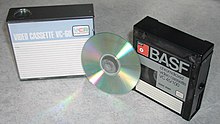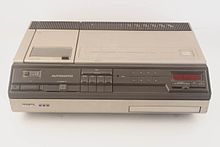VCR system

The VCR system (derived from "Video Cassette Recording") is an early analog color home video recorder system from Grundig and Philips from 1971 . It was the first commercially successful video cassette format for home use.
The videotape had his career as the audio - tape first as a loose roll band which was wound on bobbins and are threaded on an empty coil when placed on the video equipment had begun. Now, as with the audio tape, it was considered to develop a cassette system that simplifies the insertion, because it eliminates the laborious threading and the tape does not have to be touched with the fingers.
In the 1970s, Grundig and Philips further developed their already introduced black and white ( LDL ) system, which was still based on the technology of open tape reels . The reels were provided with a cassette housing in which they were attached one above the other. The cassettes were about the size of CDs, only a lot thicker. This allowed for quite large coils in a relatively compact format.
Brief technical overview
- Television standard: 625/50 black and white and color PAL / SECAM
- Band: ½ inch
- Color: degraded color
- Sound: longitudinal track (mono) / two-channel / stereo (stereo not available on all devices)
- Variants: VCR, VCR-Longplay, Supervideo (cassette name: SVC, system name: SVR )
technology
The format was able to record color video. The image resolution specified by the design of the cassette, the tape / head relative speed and other technical parameters does not allow a direct recording of the color, which is 4.43 MHz in the PAL process, with VCR. The color signal is therefore separated and reduced, similar to later on with VHS . VCR had two channels of audio, and it did so before television had stereo or bilingual audio . There were also recorders in this format for the semi-professional sector. A little later, video recorders of this first 65-minute VCR system were grouped under the standard designation “Europe Standard I”, which had to be manufactured under the specification of particularly tight manufacturing tolerances. This was to ensure program exchange and compatibility between different VCR devices.
For home users, the format was further developed from 1977 to VCR Longplay and 1978 to Super Video ( SVR , only for devices from Grundig, Siemens and ITT). The original playing time of 65 minutes increased to 180 minutes (3 hours) with long play and even to 300 minutes (5 hours) with SVR. The different systems used the same cassettes, but the recordings of one system could not be played back in recorders of the other type. The cassettes delivered from 1978 onwards were therefore labeled with three different running times VCR, VCR Longplay and SVR .
The latter two variants of the VCR system disappeared from the market within two years in favor of Video 2000 , while units of the original 65-minute system remained available until 1989.
The first VCRs at both Grundig and Philips had an exclusively mechanical drive control. Grundig introduced the fully electronically controlled tape drive with five motors in the mid-1970s. The VCR devices were thus remotely controllable, sometimes even wirelessly via additional buttons on the remote control of the connected color television.
The picture quality of the first home VCR devices is roughly comparable to that of Betamax and VHS , but with a much cleaner color reproduction. However, as with these, it is significantly below that of a directly received television picture. Due to the more favorable technical parameters due to the system (higher tape / head relative speed, color “Color Under” with “lawn” between the video tracks) compared to VHS, VCR can work without color noise suppression. The visible playback quality increased slightly with the third (and last) generation devices, especially the Grundig SVR device, and achieved a sharp and clear video quality with little color noise.
VCR was therefore suitable for the development of semi-professional and professional video recorders that made assemble and insert editing possible. Such devices came onto the market from 1974 (Philips) and 1977 (Grundig) and were offered until the mid-1980s. This involved “editing” by transferring excerpts from the recording on cassette A in the player (player) to a second device with cassette B (editing recorder). In the literal sense of the word , nothing was cut , rather the scenes were brought into the correct order through many individual dubbing processes. The Grundig device (or better: device system) was even able to process video material with image accuracy using electronic editing control.
With the longest cassettes, tape length approx. 710 m, a recording time of approx. 85 minutes was possible in VCR, approx. 180 minutes with VCR long play and approx. 305 minutes in SVR.
Technical specifications
VCR Standard / Europe Standard I.
| Head drum diameter | 105 mm |
| Rotation speed | 1500 rpm |
| Relative scanning speed | 8.1 m / s |
| Belt speed | 14.29 cm / s |
| Gap length of the video heads | 0.8 µm |
| Video track width | 130 µm |
| Video track spacing | 57 µm |
| Audio track width | 2 × 0.7 mm (track 1 on the lower edge of the tape, track 2 on the upper edge of the tape) |
| Synchronous track width | 0.3 mm (next to audio track 2, angularly decoupled in the end area of the video tracks) |
| Inclination of the head gap relative to the scanning direction | no inclination |
| Video bandwidth | 3 MHz (Y) and 650 kHz (C), or 3.2 MHz for black and white |
| Modulation of the Y (luminance) signal | FM, 3.0 MHz (sync pulse) to 4.4 MHz (white) |
| Color recording | Degraded color with carrier at 562.5 kHz |
Source: Service manual for Philips N1512 and N1502
VCR long play
| Head drum diameter | 105 mm |
| Rotation speed | 1500 rpm |
| Relative scanning speed | 8.1 m / s |
| Belt speed | 6.56 cm / s |
| Gap length of the video heads | 0.6 µm |
| Video track width | 85 µm |
| Video track spacing | 0 µm |
| Audio track width | 0.7 mm (there is only one sound track; the VCR longplay contains the synchronous track instead of sound track 2 of the VCR system) |
| Synchronous track width | 0.7 mm |
| Inclination of the head gap relative to the scanning direction | 15 degrees each, i.e. 30 degrees against each other |
| Video bandwidth | 3 MHz (Y) and 650 kHz (C) |
| Modulation of the Y (luminance) signal | FM, from 3.3 MHz (sync pulse) to 4.8 MHz (white) |
| Color recording | Degraded color with carrier at 562.5 kHz |
Source: Service Manual for Philips N1700
Great video recording
| tape | 1/2 "/ (12.7 mm) |
| Belt speed | 3.95 cm / s |
| Relative scanning speed | 8.21 m / s |
| Video track width | 50 µm |
| Video track length | 164 mm |
| Video track spacing | 0 µm |
| Audio track width | 0.7 mm (there is only one soundtrack, the SVR is where the soundtrack 2 of the VCR system is the synchronous track) |
| Synchronous track width | 0.7 mm |
| Inclination of the head gap relative to the scanning direction | 15 degrees each, i.e. 30 degrees against each other |
Source: “Service Manual” (technical manual) for Grundig SVR4004
literature
- Johannes Gfeller, Agathe Jarczyk, Joanna Phillips: Compendium of image disturbances in analog video . Ed .: Swiss Institute for Art Research . Scheidegger & Spiess, Zurich 2013, ISBN 978-3-85881-381-7 .




